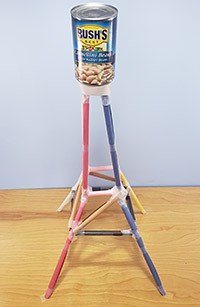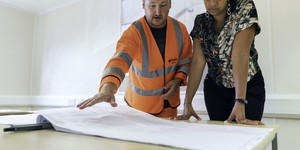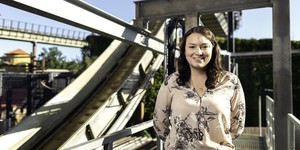Abstract
In this engineering challenge, you will use limited materials to build a paper tower as tall as possible, but there's a twist! Your tower must also support a heavy weight at the top without collapsing. Looking for inspiration? You can see how other students have tackled this and other annual Science Buddies Engineering Challenges.
Teachers, lesson plan versions of this challenge are also available.
Summary
This engineering challenge is based on an internal competition designed by employees at Fluor Corporation.
Objective
Use limited materials to build a tower that is as tall as possible and can hold a heavy weight at the top.
Introduction
Throughout the world, engineers have designed a wide variety of observation towers in different shapes and sizes (Figure 1). Unlike regular buildings and skyscrapers, which typically have rooms (offices, apartments, etc.) on every floor, observation towers may have a mostly "hollow" structure with an observation deck on top. Other similar structures that have a hollow frame with a heavy load at the top can include water towers and radio towers (Figure 2). You can download this slideshow for more pictures of different towers.
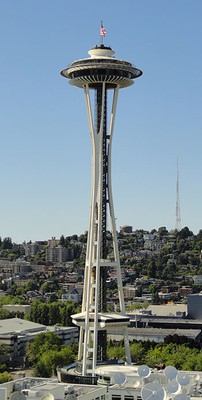 Image Credit: Wikimedia commons user Jordon Kalilich / Creative Commons Attribution Share-Alike 3.0 Unported
Image Credit: Wikimedia commons user Jordon Kalilich / Creative Commons Attribution Share-Alike 3.0 Unported
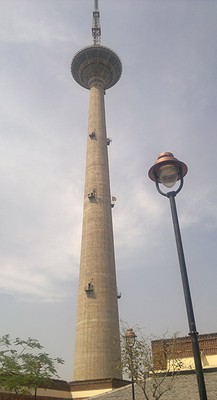 Image Credit: Wikimedia Commons user Tarunpant / Creative Commons Attribution Share-Alike 3.0 Unported
Image Credit: Wikimedia Commons user Tarunpant / Creative Commons Attribution Share-Alike 3.0 Unported
 Image Credit: Wikimedia Commons user Benh LIEU SONG / Creative Commons Attribution Share-Alike 3.0 Unported
Image Credit: Wikimedia Commons user Benh LIEU SONG / Creative Commons Attribution Share-Alike 3.0 Unported
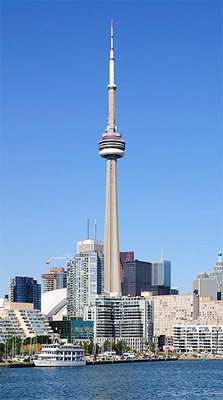 Image Credit: Wikimedia commons user Wladyslaw / Creative Commons Attribution Share-Alike 3.0 Unported
Image Credit: Wikimedia commons user Wladyslaw / Creative Commons Attribution Share-Alike 3.0 Unported
Figure 1. From left to right: the Space Needle (USA), the Pitampura TV tower (India), the Eiffel Tower (France), and the CN Tower (Canada).
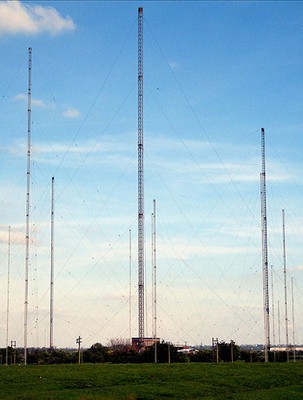 Image Credit: Wikimedia commons user G-man / Public domain
Image Credit: Wikimedia commons user G-man / Public domain
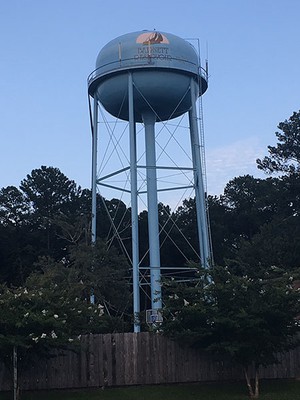 Image Credit: Wikimedia commons user Freekhou5 / Creative Commons Attribution-Share Alike 4.0 International
Image Credit: Wikimedia commons user Freekhou5 / Creative Commons Attribution-Share Alike 4.0 International
Figure 2. Radio towers (left) and a water tower (right).
The 2021 Engineering Challenge is inspired by towers like those in Figures 1 and 2. As shown in the following video, your goal is to build the tallest possible tower using only paper and tape, but the tower must also support a can of food at the top.
You can use this project to explore several topics in physics and engineering. Rather than explain each topic in detail, this Background section will give you a brief overview, and you can do more research on your own or use the links in the Bibliography.
- Beams are long, skinny elements used to make many structures like towers and bridges. Multiple beams can be combined to make trusses. Certain truss shapes can be very strong. Can you identify any trusses in Figures 1 and 2?
- An object that is being "squished" is in compression and an object that is being pulled on is in tension. Beams can be in either tension or compression, depending on how a tower is designed.
- Sometimes towers include ropes, cables, or chains as part of the design. These parts can only be in tension (think about what happens if you try to "push" a rope), but they can still be useful. For example, the long cables connected to the top of the radio towers in Figure; 2 are called guy wires. They are anchored to the ground and prevent the tall, skinny towers from falling over.
- The shape of a beam can dramatically affect its strength. For example, it is very easy to bend a flat piece of paper. It becomes much harder to bend the paper if you fold it in half multiple times or roll it into a tube. This resistance to bending is determined by the beam's cross section. For example, the cross section of a flat piece of paper is a (very thin) rectangle. This rectangle bends very easily in the thin direction. The cross section of a piece of paper rolled into a tube is a circle. An I-beam (where the cross section looks like a capital letter I) is a common shape used in many structures.
You can also use this project to demonstrate the engineering design process. It is unlikely that your tower will work perfectly on the first try—it might even collapse! You might need to iterate by testing and tweaking your design multiple times so you can continually improve it.
Terms and Concepts
- Beam
- Truss
- Compression
- Tension
- Guy wire
- Cross section
- I-beam
- Engineering design process
- Iterate
Questions
- What are some examples of tall towers throughout the world? How do these towers stay standing without falling over, even though they are very tall and skinny?
- How can you build a tower if the only materials you have available are paper and tape? What overall design would you choose for the tower? What would you do to the individual pieces of paper?
- How can you make sure that your tower can support not only its own weight, but the added weight of a can of food?
Bibliography
- Lamb, R. and Morrissey, M. (n.d.). Tension and Compression: Two Forces Every Bridge Knows Well. HowStuffWorks. Retrieved October 14, 2020.
- PBS, (n.d.). Mini-Activity: Toothpick Truss. Retrieved October 14, 2020.
- Science Buddies Staff. (n.d.). The Engineering Design Process. Retrieved October 14, 2020.
Materials and Equipment
If you want to compare your results to those of other students who did the 2021 Engineering Challenge, you can only use the materials listed below.
- Construction materials
- Paper (maximum 30 sheets). Printer, construction, graph, and notebook paper are allowed (letter or A4 size; 9" x 12" or 22 x 30-cm construction paper also allowed). Cardstock and newspaper are not allowed.
- Tape (maximum one roll), maximum 1" (2.5 cm) wide. Clear office tape (e.g. Scotch®), masking, and painter's tape are allowed. Double-sided tape, duct tape, and packing tape are not allowed.
- Hard, smooth surface, such as table or countertop
- Tools
- Scissors
- Ruler
- Pencil
- Metric tape measure or meterstick
- Stopwatch
- Unopened can of food, 14–16 oz or 400–450 g. Glass jars are not allowed for safety reasons (they could shatter if they fall off your tower).
Experimental Procedure
The objective of the 2021 Engineering Challenge is to build a paper tower that is as tall as possible and can support a can of food at the top. Figure 3 shows several examples. If you have not already done so, watch this video for an overview of the challenge before you proceed.
- The tower can only be built from paper and tape. See the materials list for allowable types of paper and tape. Tools cannot be used as structural elements of the tower.
- You cannot use more than 30 pieces of paper.
- You cannot use more than one roll of tape.
- The bottom of the tower can only be taped to the horizontal surface that it rests on (floor, table, etc.). It cannot be taped to anything else (like the vertical leg of a table or a wall) or supported by a person.
- You are allowed to fold, bend, roll, cut, etc. the pieces of paper.
- Material cost is not prorated. If you cut a sheet of paper in half and only use half the sheet, it still counts as a whole sheet.
- For scoring purposes, 1 piece of paper is 1 sheet of paper.
- The tower must support one can of food (14–16 oz or 400–500 g) for at least 1 minute without collapsing. You cannot touch, modify, or repair the tower during this minute.
- The can must rest freely on the tower and be removable. It cannot be taped to the tower.
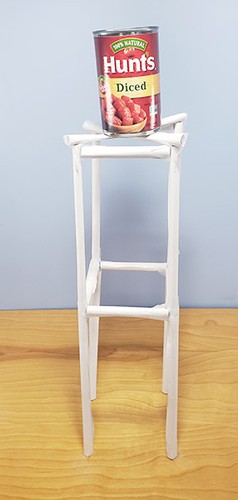 Image Credit: Ben Finio, Science Buddies / Science Buddies
Image Credit: Ben Finio, Science Buddies / Science Buddies
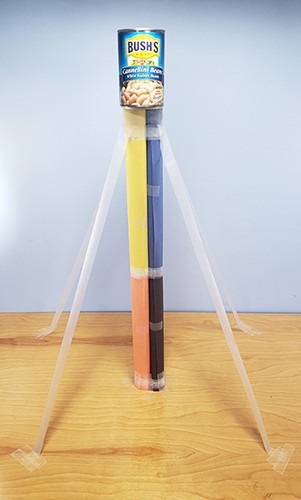 Image Credit: Ben Finio, Science Buddies / Science Buddies
Image Credit: Ben Finio, Science Buddies / Science Buddies
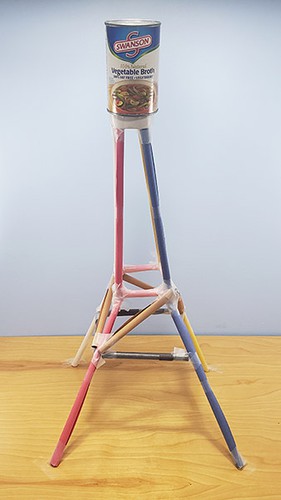 Image Credit: Ben Finio, Science Buddies / Science Buddies
Image Credit: Ben Finio, Science Buddies / Science Buddies
Figure 3. Three examples of paper towers that comply with the contest rules.
Design
Before you start building anything, it is a good idea to brainstorm some different designs. Try sketching your designs out on paper (paper used for sketching does not count toward the total used to build your tower). Remember that there is an inherent trade-off in your design. Your score depends on both the height of your tower and how much paper you use. So, it is possible for a shorter tower that uses less paper to beat a taller tower that uses more paper. However, a tower that uses less paper may be weaker and have a harder time supporting the weight of the can. Can you design a tower that is tall, lightweight, and sturdy?
Build
Once you have decided on a design, it is time to start building. You might want to practice building individual elements (for example, single beams, or connections between beams) of your tower before you try to build the entire thing. You also might want to test your tower as you build it—for example, by pressing on it gently to make sure it is sturdy enough—instead of waiting until the very end and then putting the can on top. Your design might not work as you had planned, and this is okay! Engineers do not always get things right on the first try. If your tower is not as sturdy as you thought, you can modify it (for example, by adding more tape or reinforcing beams) or go "back to the drawing board" and start over with a new design. Only paper used in your final design counts when calculating your score.
Test
When you have completed your tower, test it by gently placing the can on top. Keep your hands nearby and ready to catch the can in case it falls or the tower collapses. If your tower starts to buckle or sag and does not look like it will hold the can for an entire minute, you should reinforce it before you proceed to the official test. Make sure you keep track of the total number of pieces of paper used in your final design.
Official Test
For the official test:
- Place the can on top of the tower and immediately start the stopwatch.
- Wait for 1 minute to make sure the tower does not collapse. It is okay if the tower begins to sag or buckle, as long as the can does not touch the ground, but you cannot touch, repair, or modify the tower during this minute.
- After 1 minute has elapsed, use a tape measure or meterstick to measure the distance (in centimeters) from the supporting surface (floor, tabletop, etc.) to the bottom of the can. If necessary, you are allowed to use your hands to stabilize the tower or the can when taking your measurement, but do not lift the can to a higher height (this helps ensure that you do not accidentally knock the can over with the tape measure or meterstick—that would be frustrating!).
Scoring
Calculate your score using this equation:
Remember that the number of pieces of paper is equal to the number used in your final design. Paper used in earlier prototypes or for sketches does not count.
Troubleshooting
For troubleshooting tips, please read our FAQ: Tallest Paper Tower Challenge.
Ask an Expert
Global Connections
The United Nations Sustainable Development Goals (UNSDGs) are a blueprint to achieve a better and more sustainable future for all.
Variations
Note: the following variations are not eligible for the 2021 Engineering Challenge, but you can do them for an independent science project.
- Try building a tower with other materials like straws or wooden craft sticks.
- Try building a tower that can support more weight.
- Build a different type of structure, like a bridge.
Frequently Asked Questions (FAQ)
See the following links for more details about the challenge:
Careers
If you like this project, you might enjoy exploring these related careers:
Related Links
- Science Fair Project Guide
- Other Ideas Like This
- Civil Engineering Project Ideas
- Physics Project Ideas
- Engineering Challenge Project Ideas
- My Favorites



